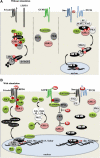GSK-3: Functional Insights from Cell Biology and Animal Models
- PMID: 22110425
- PMCID: PMC3217193
- DOI: 10.3389/fnmol.2011.00040
GSK-3: Functional Insights from Cell Biology and Animal Models
Abstract
Glycogen synthase kinase-3 (GSK-3) is a widely expressed and highly conserved serine/threonine protein kinase encoded in mammals by two genes that generate two related proteins: GSK-3α and GSK-3β. GSK-3 is active in cells under resting conditions and is primarily regulated through inhibition or diversion of its activity. While GSK-3 is one of the few protein kinases that can be inactivated by phosphorylation, the mechanisms of GSK-3 regulation are more varied and not fully understood. Precise control appears to be achieved by a combination of phosphorylation, localization, and sequestration by a number of GSK-3-binding proteins. GSK-3 lies downstream of several major signaling pathways including the phosphatidylinositol 3' kinase pathway, the Wnt pathway, Hedgehog signaling and Notch. Specific pools of GSK-3, which differ in intracellular localization, binding partner affinity, and relative amount are differentially sensitized to several distinct signaling pathways and these sequestration mechanisms contribute to pathway insulation and signal specificity. Dysregulation of signaling pathways involving GSK-3 is associated with the pathogenesis of numerous neurological and psychiatric disorders and there are data suggesting GSK-3 isoform-selective roles in several of these. Here, we review the current knowledge of GSK-3 regulation and targets and discuss the various animal models that have been employed to dissect the functions of GSK-3 in brain development and function through the use of conventional or conditional knockout mice as well as transgenic mice. These studies have revealed fundamental roles for these protein kinases in memory, behavior, and neuronal fate determination and provide insights into possible therapeutic interventions.
Keywords: GSK-3; animal models; behavior; signal transduction.
Figures



Similar articles
-
The mood stabilizing properties of AF3581, a novel potent GSK-3β inhibitor.Biomed Pharmacother. 2020 Aug;128:110249. doi: 10.1016/j.biopha.2020.110249. Epub 2020 May 26. Biomed Pharmacother. 2020. PMID: 32470749
-
A new strategy for studying protein kinase B and its three isoforms. Role of protein kinase B in phosphorylating glycogen synthase kinase-3, tuberin, WNK1, and ATP citrate lyase.Biochemistry. 2006 Jan 10;45(1):213-23. doi: 10.1021/bi050287i. Biochemistry. 2006. PMID: 16388597
-
Glycogen synthase kinase-3alpha reduces cardiac growth and pressure overload-induced cardiac hypertrophy by inhibition of extracellular signal-regulated kinases.J Biol Chem. 2007 Nov 9;282(45):33181-91. doi: 10.1074/jbc.M705133200. Epub 2007 Sep 12. J Biol Chem. 2007. PMID: 17855351
-
Effects of mutations in Wnt/β-catenin, hedgehog, Notch and PI3K pathways on GSK-3 activity-Diverse effects on cell growth, metabolism and cancer.Biochim Biophys Acta. 2016 Dec;1863(12):2942-2976. doi: 10.1016/j.bbamcr.2016.09.004. Epub 2016 Sep 6. Biochim Biophys Acta. 2016. PMID: 27612668 Review.
-
Glycogen synthase kinase-3--an overview of an over-achieving protein kinase.Curr Drug Targets. 2006 Nov;7(11):1377-88. doi: 10.2174/1389450110607011377. Curr Drug Targets. 2006. PMID: 17100578 Review.
Cited by
-
Liver-Specific Deletion of Integrin-Linked Kinase in Mice Attenuates Hepatotoxicity and Improves Liver Regeneration After Acetaminophen Overdose.Gene Expr. 2016;17(1):35-45. doi: 10.3727/105221616X691578. Epub 2016 Apr 27. Gene Expr. 2016. PMID: 27125733 Free PMC article.
-
Identification of aurora kinase B and Wee1-like protein kinase as downstream targets of (V600E)B-RAF in melanoma.Am J Pathol. 2013 Apr;182(4):1151-62. doi: 10.1016/j.ajpath.2012.12.019. Epub 2013 Feb 12. Am J Pathol. 2013. PMID: 23416158 Free PMC article.
-
2,5-Dimethylcelecoxib prevents pressure-induced left ventricular remodeling through GSK-3 activation.Hypertens Res. 2017 Feb;40(2):130-139. doi: 10.1038/hr.2016.122. Epub 2016 Sep 15. Hypertens Res. 2017. PMID: 27628899
-
Glycogen Synthase Kinase-3 Inhibition by CHIR99021 Promotes Alveolar Epithelial Cell Proliferation and Lung Regeneration in the Lipopolysaccharide-Induced Acute Lung Injury Mouse Model.Int J Mol Sci. 2024 Jan 20;25(2):1279. doi: 10.3390/ijms25021279. Int J Mol Sci. 2024. PMID: 38279281 Free PMC article.
-
Advances in Autosomal Dominant Polycystic Kidney Disease: A Clinical Review.Kidney Med. 2020 Feb 22;2(2):196-208. doi: 10.1016/j.xkme.2019.11.009. eCollection 2020 Mar-Apr. Kidney Med. 2020. PMID: 32734239 Free PMC article. Review.
References
LinkOut - more resources
Full Text Sources
Other Literature Sources

